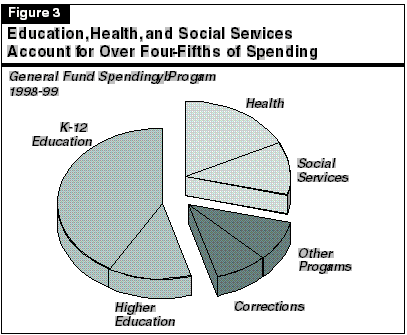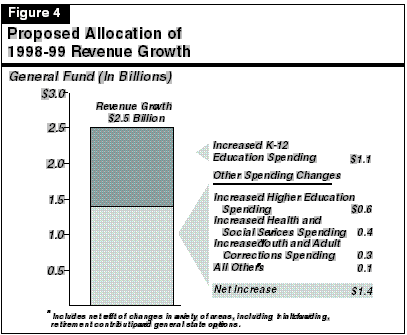![]()
California's fiscal outlook is the brightest in over a decade. Substantial revenue growth in the current year, coupled with declining caseloads in the state's health and welfare programs, has enabled the Governor to propose a 1998-99 budget which is balanced, maintains the agreements reached last year in the areas of trial court funding and tax reductions, and covers funding for caseload growth and new education initiatives.
The January budget proposal reflects the Governor's priorities for 1998-99 regarding state revenues and spending. As always, the Legislature will have an opportunity to establish its priorities through the budget process over the next several months. In addition, based on our projections of revenues and expenditures, we believe that the Legislature will have discretion over more than $1 billion in resources beyond those assumed in the Governor's proposal. This will provide the Legislature with an unusual opportunity to allocate a significant amount of unanticipated funds to meet its own priorities.
The new budget proposes total state spending of $70.6 billion (excluding the expenditure of federal funds and selected bond funds). As indicated in Figure 1 (see next page), this total includes $55.4 billion in General Fund expenditures, nearly all of which are allocated through the budget process. It also includes $15.2 billion in special funds spending, which are earmarked for specific purposes, such as highways, targeted health programs, and local governments. In terms of spending growth, the budget proposes a total spending increase of 4.7 percent, consisting of a General Fund increase of 4.5 percent, and a 5.3 percent increase from special funds.
| Figure 1 | ||||
| Total Proposed Budgetary Spendinga | ||||
| 1996-97 Through
1998-99 (Dollars in Billions) |
||||
| Actual 1996-97 |
Estimated 1997-98 |
Proposed 1998-99 | ||
| Amount | Percent Change | |||
| General Fund | $49.1 | $53.0 | $55.4 | 4.5% |
| Special fundsb | 13.3 | 14.4 | 15.2 | 5.3 |
| Totals | $62.4 | $67.4 | $70.6 | 4.7% |
| a Excludes selected bond fund expenditures. | ||||
| b Governor's budget presentation, which excludes Local Public Safety Fund expenditures. In 1998-99, these total $1.9 billion. | ||||
Figure 2 shows the Governor's estimated General Fund revenues, expenditures, and the year-end budgetary reserve for both 1997-98 and 1998-99. It shows that both the current and budget years are expected to end with a relatively modest reserve of around $300 million--a bit over one-half of 1 percent of General Fund revenues.
Figure 3 and Figure 4 (page 8) provide two alternative perspectives on how the Governor proposes to allocate General Fund expenditures in 1998-99.
How Total Spending Is Allocated. Figure 3 shows how spending from the state's General Fund is allocated among major program areas. It shows that education funding accounts for over one-half of the total budget, with K-12 education accounting for 42 percent, and higher education accounting for about 13 percent). Health and social services programs, including Medi-Cal, California Work Opportunity and Responsibility to Kids (CalWORKs) and Supplemental Security Income/State Supplementary Program (SSI/SSP), account for slightly more than one-fourth of the budget total. Spending on youth and adult corrections represents about 8 percent of the budget, and all other programs--including various state operations, retirement, and debt service--account for the remaining 10 percent of General Fund spending.
| Figure 2 | |||
| Governor's BudgetGeneral Fund Condition | |||
| 1997-98 and 1998-99
(Dollars in Millions) |
|||
| 1997-98 | 1998-99 | Percent
Change |
|
| Prior-year fund balance | $906 | $774 | |
| Revenues and transfers | 52,890 | 55,383 | 4.7% |
| Total resourcesavailable | $53,796 | $56,157 | |
| Expenditures | $53,022 | $55,416 | 4.5% |
| Ending fund balance | $774 | $741 | |
| Other obligations | $445 | $445 | |
| Reserve | $329 | $296 | |
| Detail may not total due to rounding. | |||

How Revenue Growth Is Allocated. Figure 4 shows how the budget proposes to allocate the $2.5 billion in projected 1998-99 revenue growth among major programs. Somewhat over 40 percent ($1.1 billion) of the increase is for K-12 education, which is about in proportion to K-12 education's share of the total General Fund budget. Of the remainder, $0.6 billion is proposed for higher education, $0.4 billion goes to health and social services, and $0.3 billion goes to corrections-related spending.

The final $0.1 billion of 1998-99 revenue growth is a net figure which includes a variety of offsetting elements, including: (1) a drop of over $0.7 billion in payments to the Public Employees' Retirement System (PERS), reflecting reduced payments in the budget year associated with the PERS court settlement; (2) an increase of $0.5 billion for trial court funding (due to the financial restructuring agreement); (3) $142 million for a 3 percent state employee pay increase; and (4) over $100 million for state infrastructure.
Figure 5 summarizes the key features of the 1998-99 budget proposal. As noted above, the new budget plan reflects the major agreements reached last year in the areas of welfare reform, education, state tax relief, and the financial restructuring of California's trial court system. Most of the budget's new proposals are in the areas of education and infrastructure. For example, the budget proposes funding to cover the costs of increasing the length of the K-12 school year to 180 days, as well as $7 billion in bonds to finance capital outlay needs in the areas of education, prisons, and resources.
As in recent years, the budget proposes the elimination of the renters' credit (which was suspended from 1993 through 1997), and also proposes to make permanent certain welfare grant reductions and suspensions in cost-of-living adjustments (COLAs).
| Figure 5 | ||
| Key Programmatic Features of the Governor's 1998-99 Budget Proposal | ||
Taxes
|
||
Education
|
||
Welfare
|
||
Infrastructure
|
||
Corrections
|
||
Other Programs
|
||
Among the most important assumptions underlying the proposed budget are its economic and revenue projections. In both of these areas, moderate growth is assumed.
The budget assumes ongoing national economic expansion in 1998 and 1999, accompanied by continued, though tapering, economic growth with modest inflation in California. The state's personal income is projected to increase by 6.3 percent in 1998 and 6 percent in 1999, while wage and salary employment is projected to increase by 2.8 percent in 1998 and 2.3 percent in 1999. Although these projected gains represent a slowing from 1997's robust pace, solid economic performance is anticipated during the next two years. The administration indicates that it has lowered its projections of personal income growth by about one-half percentage point in both 1998 and 1999 in order to take into account the impacts of Asia's financial and economic problems.
Moderate Revenue Growth in 1998-99.After a healthy increase in the current year, the budget assumes that moderate revenue growth will occur in 1998-99, consistent with the moderate gains projected for the economy. As shown in Figure 2, the budget projects that General Fund revenues will total $52.9 billion (7.5 percent growth) in the current year and $55.4 billion (4.7 percent growth) in the budget year.
The budget does not contain any new tax-related proposals. However, the revenue forecast does incorporate the effects of the state's 1997 tax relief package, including an increased personal income tax dependent exemption credit. The fiscal effect of this package is to reduce revenues by $189 million in 1997-98 and $593 million in 1998-99 (reaching $1.1 billion in 1999-00 when fully phased in). In the absence of this tax package, projected 1998-99 revenue growth would have been modestly higher--5.5 percent. The budget also assumes $85 million in 1998-99 revenues from federal adoption of an "Internal Revenue Service tax offset" program (this program also has been assumed, but not adopted, in the last few years).
Recent Cash Trends Have Been Strong. In December, General Fund cash receipts exceeded the 1997-98 Budget Act forecast by over $700 million, more than offsetting the revenue softness that had occurred earlier in the year. These unanticipated tax payments were largely estimated payments on 1997 tax liabilities. Because these payments were not received until after the administration completed its revenue forecast, they were not directly incorporated into the forecast. The unexpected payments were primarily related to strong year-end personal income tax receipts. The strong year-end payments suggest that final payments made in April 1998 will be strong as well (given historical experience) and that the current revenue trend is above the budget forecast.
Return to 1998-99 Perspectives and Issues Table
of Contents
Return to LAO Home Page